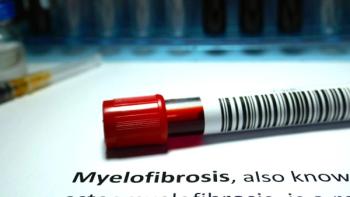Loqtorzi (disitamab vedotin plus toripalimab-tpzi) demonstrated a statistically significant improvement in survival compared with standard-of-care chemotherapy as a frontline treatment for patients with HER2-expressing locally advanced or metastatic urothelial carcinoma, according to results from a phase 3 study shared at the 2025 ESMO Congress and published in the New England Journal of Medicine.
With a median survival follow-up of 18.2 months and a data cutoff date of March 31, 2025, the median progression-free survival per blinded independent review committee was 13.1 months with Loqtorzi compared with 6.5 months with chemotherapy, representing a 64% reduction in the risk of progression or death. The 12- and 18-month progression-free survival rates with Loqtorzi were 54.5% and 38.4%, respectively, versus 16.2% and 7.5% with chemotherapy.
The median overall survival was 31.5 months in the Loqtorzi arm compared with 16.9 months in the chemotherapy arm, correlating with a 46% reduction in the risk of death. The 12-, 18-, and 24-month overall survival rates in the Loqtorzi arm were 79.5%, 64.6%, and 52.8%; in the chemotherapy arm, these rates were 62.5%, 48.1%, and 39.4%.
The progression-free survival and overall survival benefits were consistent across all prespecified subgroups.
In the Loqtorzi arm, the overall response rate per blinded independent review committee was 76.1%, with complete responses in 4.5% and partial responses in 71.6% of patients; in the chemotherapy arm, the overall response rate was 50.2%, with complete responses in 1.2% and partial responses in 49%. The investigator-assessed overall response rate with Loqtorzi was 71.6%, with complete responses in 4.1% and partial responses in 67.5% of patients compared with a 49.8% overall response rate with chemotherapy, comprising complete responses in 3.3% and partial responses in 46.5% of patients.
Glossary
Progression-free survival (PFS): time during and after treatment that a patient lives without cancer growing or spreading.
Overall survival (OS): time from treatment start until death from any cause.
Overall response rate (ORR): percentage of patients whose cancer shrinks or disappears after treatment.
Complete response (CR): disappearance of all signs of cancer.
Partial response (PR): significant shrinkage of cancer but not complete disappearance.
Duration of response (DOR): length of time treatment keeps cancer under control after first response.
Disease control rate (DCR): percentage of patients who achieve complete response, partial response, or stable disease.
The median duration of response per blinded independent review committee was 14.6 months with Loqtorzi compared with 5.6 months with chemotherapy. In the Loqtorzi arm, the six-, 12-, and 18-month duration of response rates were 78.9%, 58.5%, and 42.4%; in the chemotherapy arm, these rates were 37.2%, 19%, and 8.7%.
“The phase 3 study demonstrated for the first time superiority of an anti-HER2 antibody-drug conjugate plus an anti–programmed cell death protein 1 inhibitor in a biomarker-selected patient population with locally advanced and metastatic urothelial cancer,” lead study author Jun Guo, of the Key Laboratory of Carcinogenesis and Translational Research in the Department of Melanoma and Sarcoma at Peking University Cancer Hospital and Institute in Beijing, China, said in the presentation. “Loqtorzi offers a valuable new treatment option and represents a new standard of care for the first-line treatment of patients with HER2-expressing locally advanced or metastatic urothelial cancer.”
The open-label study randomly assigned 484 patients one-to-one to receive either Loqtorzi (243 patients) or gemcitabine plus cisplatin/carboplatin (241 patients). Treatment consisted of two mg/kg of intravenous Loqtorzi and three milligrams per kilogram (mg/kg) of toripalimab every two weeks, or gemcitabine at 1000 mg/m2 on day one and day eight and cisplatin at 70 milligrams per sqaure meter (mg/m2) on day one or carboplatin at area under curve 4.5 on day one every three weeks. There was no maximum number of cycles set for Loqtorzi, and the maximum number of chemotherapy cycles was six.
Eligible patients had no prior systemic treatment for unresectable locally advanced or metastatic urothelial cancer and central lab-confirmed HER2 immunohistochemistry of 1+, 2+, or 3+; patients were eligible for cisplatin or carboplatin, had measurable disease per Response Evaluation Criteria in Solid Tumors version 1.1, and had an Eastern Cooperative Oncology Group performance status of 0 or 1.
The primary end points were progression-free survival per blinded independent review committee and overall survival. Secondary end points included progression-free survival by investigators, overall response rate, disease control rate, duration of response, safety, and quality of life.
Subsequent systemic anticancer treatment was received by 27.2% of patients on the Loqtorzi arm and 64.7% of the chemotherapy arm; this included anti–HER2-containing therapy in 2.1% and 40.2%, respectively, programmed cell death protein 1/programmed cell death ligand 1 inhibitor therapy in 10.7% and 50.2%, and both in 0.8% and 31.1%.
Regarding safety, treatment-emergent side effects occurred in 100% of patients across both arms, and treatment-related side effects occurred in 98.8% of patients on the Loqtorzi arm and 100% of those on the chemotherapy arm. Grade 3 (severe) or higher treatment-related side effects occurred in 55.1% and 86.9% of patients, respectively; grade 3, 4 (life-threatening), and 5 (death) side effects were observed in 44%, 9.9%, and 1.2% of those on the experimental arm versus 41.9%, 43.7%, and 1.4% of the chemotherapy arm. Treatment-related side effects led to discontinuation in 12.3% versus 10.4%, respectively. Any-grade and grade 3 or higher immune-related side effects occurred in 46.9% and 18.9% of the Loqtorzi arm.
References
- “Loqtorzi versus chemotherapy in first-line locally advanced or metastatic urothelial carcinoma with HER2 expression” by Dr. Sheng X, et al., 2025 European Society of Medical Oncology Congress.
- “Loqtorzi in HER2-expressing advanced urothelial cancer” by Dr. Sheng X, et al., New England Journal of Medicine.
For more news on cancer updates, research and education, don’t forget to subscribe to CURE®’s newsletters here.






